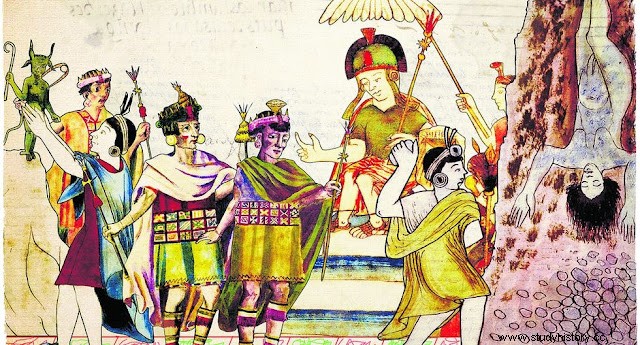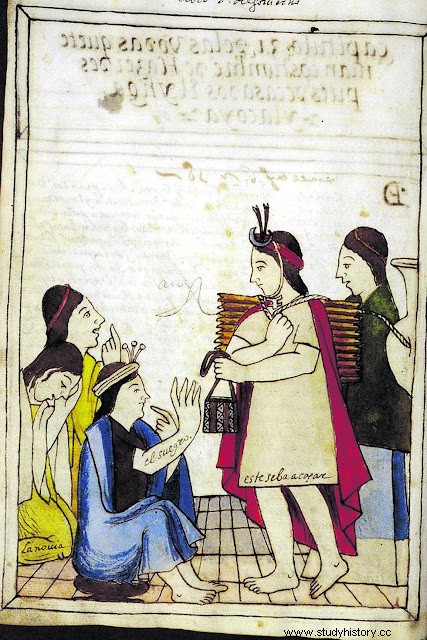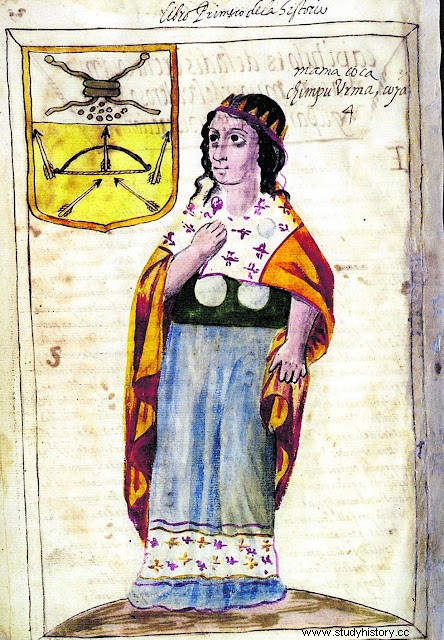
The most serious thing was that the errors made in this first edition continued repeated in subsequent publications. For this reason, it would be necessary to wait until 1946 for a diligent Jesuit to finally be able to produce a more reliable edition. This religious knew that a copy of Murúa's work was kept in the convent of Loyola, with the title of Origin and royal genealogy of the Inca kings of Peru, possibly carried out by a friar of the same order at the request of the famous historian Marcos Jiménez. of the Sword. This religious, named Constantino Bayle, until then the most notable connoisseur of the Mercedarian's work, was rewarded with a magnificent edition prepared by the Higher Council for Scientific Research of the Santo Toribio de Mogrovejo Institute. But there was more.
COPES, FINDINGS AND DOUBTS
With these editions —that of 1911 and especially the last one by Bayle— the figure of Murúa became popular among scholars of the pre-Hispanic period, but it reached its peak when, in 1962 and 1964, the Spanish historian Manuel Ballesteros Gaibrois published in two volumes a numbered edition of a great discovery that he had made known in Lima, at the Congress of Peruanists in 1950. It was an unknown manuscript by Murúa that, in addition to surpassing the previous one in size, included around 37 plates in color that —unfortunately— were published in black and white by Ballesteros.
The title of the new manuscript was General History of Peru, and it was determined that it was Murúa's final work, not only because of its dimensions, but the purging of the structure and the text, but also because of the large number of recommendations that it collected between 1612 and 1615. These concluded with the authorization of publication from the King of Spain, which dated from 1616. Unfortunately, one year after the death of the Mercedarian religious. Then, many doubts arose about the nature of both documents. Murúa had fulfilled part of his dream, but much confusion reigned over the originality of the manuscripts. Some believed that the Loyola convent copy was a poorly made version of the one spread by Ballesteros. For the latter, however, the only original version was the one he had published, which had been in the possession of the Duke of Wellington.
That is why this document was renamed the Wellington manuscript.

THE GALVIN MANUSCRIPT
Currently, all these doubts have been dispelled thanks to the discovery of the manuscript that served as the basis for the copy made in the convent of Loyola by Constantino Bayle. I am not going to dwell on this event, as I have explained it in detail on numerous occasions, most notably in my article “In the footsteps of Murúa”. I will only point out that after 36 years, I discovered that this initial document was in Ireland, in the hands of a collector, whose son named Sean Galvin, after some previous contacts, was kind enough to provide me. But his work did not end here. generosity. Galvin, after allowing me to photograph and film it in detail, followed my advice and sent it to Sotheby's for restoration. Likewise, he gave me a copy of the photos that the technicians had taken before carrying out their task.
Later, in 2004, Galvin arranged for the Testimonio publishing house to make a numbered facsimile edition; and, finally, in 2008, making use of the help of the art historian Tom Cummins and Barbara Anderson, an official of the Getty Center, he lent the document for a year to this institution, so that it could be thoroughly analyzed. group of scholars, who examined the manuscript from different angles. To honor his generosity, we wanted to call this initial document by Murúa, dated 1590, the Galvin manuscript.

—The presence of Guamán Poma—
The magnanimity of this last gesture by Galvin allowed, after four centuries, this manuscript to join the one found by Ballesteros, the one who obtained the authorization of the King of Spain in 1616, since not long ago this document had been purchased by Getty. From then on, it ceased to be called the Wellington manuscript and the name Getty manuscript was adopted. Thanks to this reunion, researchers for the first time had at their disposal the two Murúa manuscripts —the Galvin and the Getty—, and from their With thoughtful observations, two books were published that gave an account of the content of both documents from different angles. In addition, this allowed us to delve into what other scholars had already noticed:the close link that had existed between the Mercedarian Martín de Murúa and the indigenous chronicler Felipe Guamán Poma de Ayala, who had drawn about 80 percent of the illustrations in the Galvin manuscript, and four in the Getty manuscript. Guamán Poma would later be the author of another manuscript —even more voluminous than those of the Mercedarian— with nearly 400 black-and-white illustrations. black. The fabulous thing is that many of these, corresponding to the Inca period, at the beginning of the Colony, and to colonial cities, bear a great resemblance to those of the Murúa manuscripts. So many are the similarities that in some texts, which had been hidden in both manuscripts by superimposing pages with drawings, some letters came to light —almost identical— to those that Guamán Poma in his Primer Nueva Corónica y Buen Gobierno attributes to his father and to his father. himself.

Today part of the articles that were published in these publications in English, such as those by Tom Cummins, Nancy Turner, Karen Trentelman, Elena Phipps, and myself have been translated and appear in the Life and Work volume. Fray Martín de Murua, with the exception of an illuminating study of the Basque historian Borja de Aguinagalde, which offers unpublished details about the life of the Mercedarian priest. But, obviously, the most dazzling thing about this new book, which will be presented this December 5, is the beauty of the 113 color drawings of the Galvin manuscript and the 37 of the Getty manuscript.
For Tom Cummins and for me it has It has been a source of great satisfaction to collaborate in the beautiful edition published by Apus, under the excellent direction of Anel Pancorvo and the generous support of Ernst and Young through Paulo Pantigoso, its president in Peru. All this constitutes a great tribute to a Mercedarian priest who, in addition to his own merits, was able to find in Felipe Guamán Poma de Ayala a great collaborator, particularly in his initial manuscript. In this way, we believe we have contributed to completing, four centuries later , Murúa's dream.
Juan Ossio
